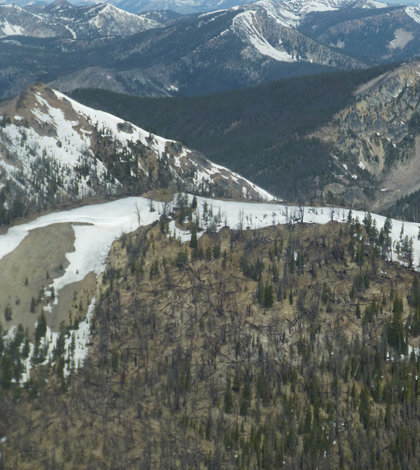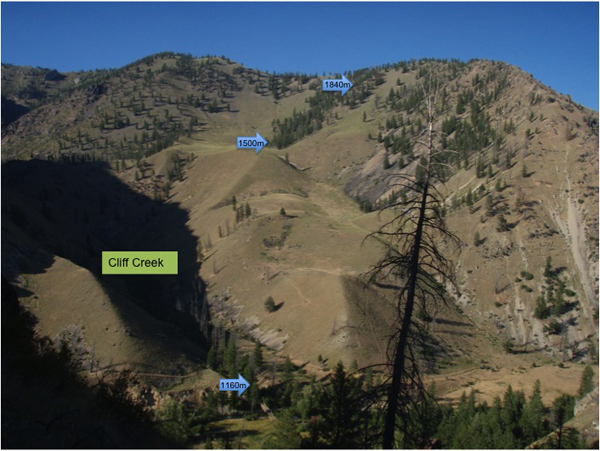Ecosystem monitoring network in Idaho wilderness seeks clear climate signal

The Frank Church Wilderness Area is among the most remote areas in the U.S. (Credit: Jill Maxwell)
Environmental monitoring stations across the country are piling up data that will help scientists tease out the the long-term effects of climate change. But many of them sit near areas of human development like airports, highways and tall buildings–all of which can influence climatic variables like wind patterns and air temperatures.
“So sometimes you lose a signal in all the noise from just the land use changes that are going on and affecting the microclimate near the station,” said Katy Kavanagh, professor in the University of Idaho’s Department of Forest, Rangeland and Fire Sciences.
Scientists like Kavanagh hope to gain a clearer signal by establishing ecosystem monitoring networks in remote areas that see fewer effects from human settlements.
Few institutions are likely better suited to manage one of those networks than the University of Idaho, which owns and operates a research station within the Frank Church—River of No Return Wilderness Area, one of the most remote places in the United states.
“It’s the largest contiguous wilderness area in lower 48, and we’re just about smack-dab in the middle of it,” Kavanagh said of the university’s Taylor Wilderness Research Station.
Over the past two years Kavanagh and a team of faculty and technicians have developed and constructed the Mountainous Ecosystem Sensor Array, a three-station network of instruments collecting continuous data on climate and forest productivity over a 2,000-foot elevational gradient.
MESA’s variation in elevation could prove just as useful as it’s remoteness. Unlike many federal wilderness areas that are squeezed on to rocky tops of mountains, the Frank Church area runs “from mountaintop to river bottom,” Kavanagh said. That allows for a significant gain between the network’s lowest and uppermost stations.

MESA’s three sites cover a 2,000-foot elevation change (Credit: Katy Kavanagh)
That’s important because many climate models operate on grids with cells as large as 10 kilometers across. When a model assigns a single climate pattern to such a wide swath of land covering mountainous terrain, the difference in elevation are effectively smoothed out.
“So a lot of the complexity of what’s going to happen is lost, Kavanagh said. “We’re hoping to capture some of that variability over time and understand how what’s going on up at the upper elevations is different than what’s going on at the lower elevations.”
They’ll capture that variability with 76 sensors spread over three sites. Each site includes instruments to measure snow depth, soil temperature and soil moisture at four depths down to around 50 centimeters. They’re also measuring carbon dioxide concentrations, air temperature, relative humidity and wind speed and direction and various points in and above the tree canopy.
Installing those sensors in a federally protected wilderness area came with a particular set of hurdles. They couldn’t install large towers, so they had to mount the instruments to trees. To avoid damaging trees with screws or pins, they secured the equipment with straps. They couldn’t install standard blade-and-rotor wind turbines to supplement their solar panels for power, so they turned to low-profile wind generators developed in England for the yachting industry.

Sensors, including a Vaisala WXT520 Weather Sensor, mounted on a mast extend above the tree canopy (Credit: Jill Maxwell)
They also had to make sure everything would hold up well against the elements because the stations are difficult to access. The farthest from the research station is three miles out and 2,000 feet up. And that’s assuming the right technician is already at the station, which is only accessible by plane in the winter and a 30-mile hike in the summer.
“We tried to make a sensor network that was robust but had the smallest footprint as possibly so that it wouldn’t intrude on any of the wilderness characteristics,” Kavanagh said.
The moisture and radiation sensors will provide data on key indicators of forest ecosystem productivity in this semiarid environment, where it stops ranging on a regular basis in late June or early July doesn’t start again until tip October. That makes plants there reliant on water stored in the soil. The amount of water in the soil and the rate at which it’s withdrawn are highly connected to the carbon cycle how productive the forest is.
“By measuring both carbon dioxide concentrations and soil moisture, we’re hoping to be able to describe periods of forest productivity, and also how the trees rely on the conditions that are in the soil as well as in the atmosphere.”
Top image: The Frank Church Wilderness Area is among the most remote areas in the U.S. (Credit: Jill Maxwell)




0 comments